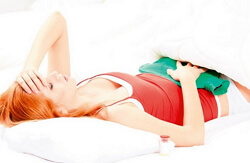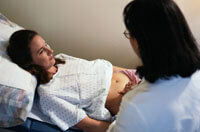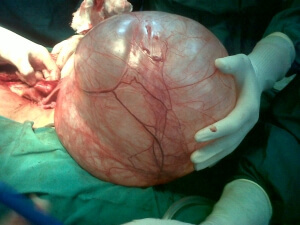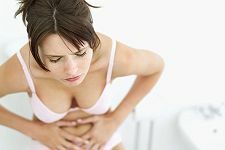Menstrual pain
 Menstrual pain is a cyclic painful sensation of varying intensity accompanying menstruation. Not entirely pleasant subjective sensations accompany menstrual bleeding in almost every woman, but not all of them are classified as pathological. These include menstrual pains in the lower abdomen.
Menstrual pain is a cyclic painful sensation of varying intensity accompanying menstruation. Not entirely pleasant subjective sensations accompany menstrual bleeding in almost every woman, but not all of them are classified as pathological. These include menstrual pains in the lower abdomen.
In the majority( 80%) of women, the period of active uterine bleeding is accompanied by a moderate soreness, when pulling or aching sensations appear in the lower abdomen. They do not distort the habitual life rhythm, do not require medical correction, last very briefly( usually 2-3 days) and pass independently. In addition, in healthy women, moderately painful menstruation does not recur from the cycle to the cycle, but has a temporary, episodic nature and proceeds without concomitant pathological symptoms.
Sensations of pain and discomfort in case of a month are explained by contraction of uterine musculature. When the blood and fragments of the exfoliated endometrium accumulate in the uterus, it becomes necessary to quickly release the uterine cavity from them. The uterine wall begins to shrink rhythmically, and its contents are evacuated, and unpleasant subjective sensations in the projection of the uterus may appear. The stronger the musculature of the uterus, the higher the likelihood of pain.
There is an opinion that menstrual pains are a consequence of an increase in the concentration of prostaglandins in the endometrium and blood plasma. Prostaglandins are complex chemical compounds that have a pronounced biological activity and affect energy metabolism. They stimulate and enhance the contractile function of the myometrium during labor. At high concentrations of prostaglandins, the uterus during menstruation is reduced too intensively, provoking a violation of blood supply to certain areas of the myometrium and, consequently, severe menstrual pain.
Before discussing changes in monthly parameters, you first need to determine which menstruation refers to "normal".In most women, the concept of "norm" is consistent with regular menstrual bleeding with an interval of 25-35 days, which last no longer than seven and not less than two days. Physiological menstruation should not be too scarce( less than 40 ml), or excessively abundant( more than 150ml).The blood loss, as a rule, is distributed throughout the months, it is unequal: the "most abundant" are the first 2-3 days, and then the amount of blood lost gradually decreases. It is "abundant days" that often occur with menstrual pain, much less often women feel pain throughout the menstrual bleeding.
For convenience, patients are asked to measure menstrual blood loss by the number of sanitary napkins that are replaced per day. With physiological blood loss, a woman uses no more than 4 pads a day.
Normal menstruation allows moderate menstrual pains in the lower abdomen, which do not interfere with a woman's habitual life. Strong menstrual cramps always signal poor health and require a detailed clinical examination. However, it should be noted that the perception of pain in women is not equal and depends on the individual pain threshold. Therefore, complaints of painful periods can not serve as a basis for a reliable diagnosis without further detailed search for their causes.
If menstrual pains do not always signal a pathology, which ones should be paid special attention:
- Menstrual pain should certainly be alarmed for menstrual disorders, including dysfunctional uterine bleeding, menorrhagia( profuse monthly with a clear periodicity), metrorrhagiaIrregular bleeding without established time intervals), polymenorrhoea( frequent menstruation), intermenstrual bleeding and others.
- If menstruation is accompanied, in addition to pain, by a marked fever, a deterioration in overall well-being, the appearance of a large number of dark clots in menstrual blood, the cause of painful menstrual periods is often an acute inflammatory process in the pelvic cavity. As a rule, the intensity of pain against the background of inflammation tends to increase, the pain continues throughout the menstrual period, and sometimes does not cease after its termination.
- The appearance of severe menstrual pains on the background of delay often makes you think about a possible interrupted pregnancy( including ectopic).
- The pathological cause of pain with menstruation is indicated by its appearance before the onset of menstrual bleeding.
- The seriousness of the causes of painful menstrual periods is indicated by their persistent nature, when the menstrual pain( as it seems without obvious serious reasons) appears monthly.
Diagnosis of the causes of menstrual pain begins with the study of complaints and gynecological examination. Sometimes the cause of pain is established already at the initial stage of the examination, when the patient clearly indicates a provoking situation: exacerbation of chronic inflammation, severe stress, excessive physical exertion on the eve or during menstrual bleeding, and others.
Laboratory diagnostics helps to exclude the infectious nature of menstrual pain, determine the state of the hormonal background, and instrumental examination methods( ultrasound, MRI, CT, hysteroscopy and the like) are required for more in-depth search.
It should be noted that pain during menstruation is not always associated with pathological processes in the genitals. If the genitals are not diagnosed during the examination of organic pathology, the painful months are correlated with the physiological process based on the violation of the neuroendocrine, metabolic and psychoemotional systems.
Treatment of menstrual pain should always be consistent with their cause. Withdrawal of menstrual pain does not mean its cure, therefore in therapy not only anesthetics are used against menstrual pain. It is necessary to work on the cause of the disease and prevent its aggravation.
Causes of menstrual pain
Sometimes painful periods occur because of completely innocuous reasons. For example, menstrual pain can result from an improperly organized lifestyle during menstruation, when patients are too physically stressed: they lift weights, go in for sports, and also perform work associated with significant physical activity. To increase the pain during menstruation is capable of hypothermia and colds, stresses and significant psycho-emotional stress. As a rule, the painful periods that have arisen for these reasons arise only once, respond well to self-administered remedies for menstrual pain and are no longer repeated.
Diagnostically important criterion is the time of the onset of painful menstruation. Conditionally, all menstrual pains are classified according to the moment of appearance on the primary and secondary.
Primary menstrual pains appear very early - during the first monthly( menarche) setting, or no later than one and a half years later. When examining girls with primary menstrual pains, there are no pathological abnormalities on the part of the genital organs, but a large number of so-called "systemic" symptoms associated with functional disorders in the work of other( non-sexual) systems of the body - nervous, endocrine, psychoemotional and so on, are always diagnosed..
The most common causes of primary menstrual pain are:
- Endocrine disruptions leading to hormonal dysfunction and distortion of the correct secretion of prostaglandins.
- Mechanical obstructions for the timely evacuation of the contents of the uterine cavity during menstrual bleeding. These include, first of all, congenital malformations of the genitals: abnormal position of the uterus or its abnormal structure, partial or complete infection( atresia) of the cervical cavity.
- Constitutional features, namely sexual infantilism, because of which the musculature of the uterus remains in an underdeveloped state and is not capable of correctly emptying the uterus during menstruation.
- Psychoemotional. Strong stress, long emotional experiences and depression can change the proper functioning of the brain, including menstrual cycle control centers. Also, stress can change the perception of pain by changing its threshold.
Sometimes the source of primary menstrual pain remains unclear. If the examination of a patient with primary menstrual pain does not reveal any organic or functional pathology, menstrual pain is considered an individual norm and correlated with a low pain threshold. Thus, primary menstrual pain, according to the cause of appearance, can be classified into psychogenic( excessive lability of the nervous system and / or astheno-vegetative syndrome), spasmogenic( loss of the ability of the myometrium to contract correctly) and essential( individual variant of the norm).
Menstrual pain of secondary origin appears against the background of gynecological diseases, which are their cause. Painful monthly can accompany infectious and inflammatory diseases of the genital area, fibroids and polyps of the uterus, endometriosis, adhesions and other ailments associated with organic changes in the organs of the pelvic cavity. Sometimes secondary menstrual pains are provoked by an intrauterine device.
Symptoms and signs of menstrual pain
Primary menstrual pains manifest themselves from the first menstruation or appear in the first year and a half after their onset. More often they appear in girls and women of asthenic constitution, having a small mass of the body and a labile psyche.
Painful menstruation of secondary origin appears in women 30-40 years with gynecological pathology, having a history of childbirth, abortion, long-term infertility, chronic infectious diseases and surgical interventions.
Among the complaints of patients, pain syndrome is more often mentioned. Usually the pain appears 12 hours before the start of another menstruation and gradually increases to the beginning of menstrual bleeding, however its duration is not always the same. As a rule, primary menstrual pains are most pronounced in the first 2 to 42 hours of menstrual bleeding, and then become insignificant or disappear altogether. The intensity of pain is also not the same. Pain can be aching, bursting, pressing, and can acquire brighter features - become cramped, sharp, irradiate into adjacent zones and organs.
It is accepted to distinguish several degrees of manifestation of the pain syndrome:
- The first, the easiest, degree differs with minor pain sensations without accompanying negative systemic symptoms. Usually there are minor pulling, aching or pressing mild sensations for a short time, equal to a period of profuse menstrual bleeding. The patient feels well and continues to lead an active life without taking pills from menstrual pain, but over time the pain syndrome can worsen.
- The second, moderate, degree of menstrual pain is characterized by a brighter clinic. Pain repeats every menses and is accompanied by other, systemic, pathological symptoms, and in case of secondary pains, the patient develops symptoms of the underlying disease. This degree of pain in the case of menstruation can no longer be ignored, as it worsens well-being and does not allow us to lead a familiar life. The patient always has to take an anesthetic for menstrual pain of the second degree. An important diagnostic criterion, which allows to differentiate this degree of pain syndrome from others, is the rapid withdrawal of menstrual pain by medication.
- The third degree of menstrual pain can be called very severe. Pelvic pain is so strong that it deprives the patient of the opportunity to get out of bed. Systemic symptoms are more intense. No independently taken remedies for menstrual pain of the third degree of severity do not alleviate the condition of the patient.
Not always the cause of menstrual pain is obvious, often for its search requires a large list of diagnostic measures. They are carried out until the sources of pain are detected.
The examination begins with the examination of complaints, general and gynecological examination. More often patients with menstrual pains are young( under 30 years old), have a specific constitution, emotional lability and an "exhausted" appearance.
In adolescents, primary menstrual pains are leading among complaints in menstrual cycle disorders in combination with premenstrual syndrome.
Systemic disorders accompanying menstrual pain of any origin are conventionally classified into:
- Vegetative: migraine headaches, heart rhythm disturbances, heart pain, alternation of chills and intense sweating, dysfunction of the digestive tract, vomiting, swelling of the face and limbs, weight gainOn the eve of menstruation, fluctuations in blood pressure, fainting, and many others.
- Psycho-emotional: shortness of breath or choking, "lump in the throat", frequent unmotivated mood change, bad sleep, apathy, anxiety and decreased appetite.
Secondary menstrual pains are always combined with the symptoms of the gynecological illness that caused them. The most common causes of painful menstruation of secondary origin are:
- Endometriosis. This complex hormone-dependent pathology provokes pain for several( 5-7) days before the onset of menstruation. As a rule, in addition to pain, appear and smearing dark discharge. The pain in endometriosis continues after the end of menstrual bleeding. Often they subside only to the middle of the cycle.
- Myoma of the uterus. Formed in the thickness of the uterine wall, myomatous nodes disrupt the contractile ability of the myometrium, provoking cramping menstrual pains.
- Inflammatory diseases and their main complication is the adhesion process. Adhesions change the position and mobility of the pelvic organs. In the adhesive process, the pain syndrome is not limited to the period of menstruation, the pains are permanent, and only intensify during menstrual bleeding.
When examining a patient's complaints it is important to find out what medications she receives from menstrual pain and how effective they are.
Laboratory diagnosis is most significant in secondary menstrual pain. If they were caused by an infectious process, the results of a study of the microbial composition of the vaginal discharge and cervical canal( smear, sowing, etc.) help determine the "culprit" of inflammation.
Also in the laboratory study, the level of the main hormones( LH, FSH, estrogens, progesterone and others) is determined.
Ultrasonic scanning of the pelvic cavity is performed by all patients with menstrual cramps. It allows to determine the condition of the uterus and appendages, to detect pathological formations( cyst, myoma, polyp, foci of endometriosis and others) and to study the state of the endometrium.
To diagnose the cause of primary menstrual pain, it often requires the help of related specialists: endocrinologists, neuropathologists, therapists and others.
If the pain does not change with the monthly, they are considered to be compensated, and if they progress from cycle to cycle, become more pronounced and prolonged, they speak of decompensated menstrual pains.
It should be emphasized once again that if menstrual pains were limited to only one menstruation, and the subsequent menstrual pains were normal, the situation is physiological and does not require detailed examination and treatment.
Treatment of menstrual pains
Secondary menstrual pains are never treated isolated from the underlying disease, because painful menstrual pains only after adequate treatment of the ailment that caused them. The therapeutic scheme integrates any pain reliever with menstrual pain, and the main treatment measures are aimed at their cause.
Treating primary menstrual pain is not easy, because they do not have an organic basis, but are associated with systemic disorders. Therapeutic tactics depend on the severity of menstrual pain. The first, easy, degree without accompanying serious system failures can be cured without the involvement of medications. Light menstrual pains pass independently after a change in lifestyle, nutrition and reduce stress on the nervous system. To prevent development of vegetative and metabolic disorders, antioxidants, in particular vitamin E.
, are sometimes recommended. Since excessive synthesis of prostaglandins plays an important role in the development of the pain syndrome, it is necessary to eliminate it for relief of menstrual cramps. This task is successfully handled by a group of non-steroidal anti-inflammatory drugs: Aspirin, Nimesulide, Diclofenac, Ibuprofen and the like. They can be used in various dosage forms - candles or tablets.
Medicinal candles for menstrual pain are very popular in patients because of their ease of use and quick healing effect. They can contain antibacterial, antispasmodic and anti-inflammatory components that enhance analgesic effect.
When choosing a method of therapy for menstrual pain, the hormonal function of the body is always taken into account. Often, patients with menstrual pain are diagnosed with hormonal dysfunction, hormonal drugs are used to eliminate it. Hormonal pills for menstrual pain are selected taking into account the level of estrogens.
Self-medication of this condition is unacceptable. Selected tablets or candles at random for menstrual pain can temporarily eliminate pain, but are unable to eliminate their cause.



